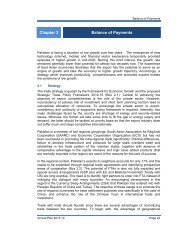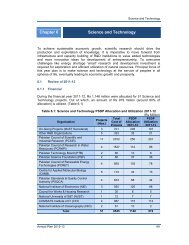Manual for Development Projects - Planning Commission
Manual for Development Projects - Planning Commission
Manual for Development Projects - Planning Commission
Create successful ePaper yourself
Turn your PDF publications into a flip-book with our unique Google optimized e-Paper software.
Chapter-7<br />
14 Tendering S R<br />
15 Evaluation of Tender T S<br />
16 Award of Contract U T<br />
17 Construction of Civil Works V U<br />
18<br />
Procurement of Machinery / other<br />
W<br />
inputs<br />
K / L / V<br />
19<br />
Installation of machinary /<br />
equipment<br />
X W<br />
20 <strong>Commission</strong>ing / Completion Y V / X<br />
Increase in Scope of Work and Delay in Execution of <strong>Projects</strong><br />
7.5 The project implementation agencies/departments should seek the approval of the competent<br />
authority as soon as they consider change in the scope of work was imminent. The sponsoring agencies<br />
should also anticipate the likely delays <strong>for</strong> taking remedial actions well in time (Annexure-XXXIX).<br />
They should also fix responsibility <strong>for</strong> delays, if any, in terms of ECC's following decision dated<br />
December 27, 1988 in case No. CEC-542/37/33:-<br />
"Those responsible <strong>for</strong> not undertaking <strong>for</strong>ward planning and causing delays in implementation of<br />
projects should be taken to task".<br />
Page 4 of 26<br />
Project Execution / Supervision-<strong>Development</strong> of Management In<strong>for</strong>mation System (MIS)<br />
7.6 The Project Director, supported by ancillary staff, will coordinate day-to-day activities and through<br />
effective management ensure that the project achieves its development objectives and deals with the<br />
problems that arise during implementation. Although the problems of implementation are to be tackled<br />
mainly at the level of the Project Director/Executing Agency, the fullest support of the higher levels ie<br />
the line departments and ministries is also essential. For the closest rapport among all the layers of<br />
responsibility, a Computerized Management In<strong>for</strong>mation System (MIS) can prove crucial and must be<br />
instituted to coordinate the flow of in<strong>for</strong>mation amongst the Project Director, Executing Agency, the<br />
sponsoring agency and the line department or the ministry concerned. At the heart of the system lies the<br />
network diagram, which presupposes the introduction of management techniques such as critical path<br />
methods (CPM), project evaluation and review techniques (PERT), etc., which at present are much in use<br />
abroad. With their assistance, it will be possible <strong>for</strong> the Project Director to take up the critical activities<br />
<strong>for</strong> implementation in the right sequence. Besides, significant milestones could be determined and<br />
regularly monitored by the project management, the sponsoring agency and line department or ministry to<br />
ensure that actions are taken in time, especially <strong>for</strong> the appointment of consultants, contractors,<br />
procurement of inputs, inter-agency coordination and fund releases.<br />
7.7 The Project Director, who is supposed to have studied and grasped the provisions of PC-I and the<br />
contract agreements, keeps a vigilant eye on availability of standardized machinery, material and<br />
http://hd2/pc/popup/ch7_p.html<br />
9/23/2010

















